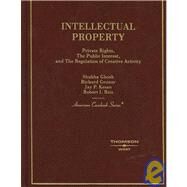Intellectual Property : Private Rights, the Public Interest, and the Regulation of Creative Activity
, by Ghosh, Shubha- ISBN: 9780314168016 | 031416801X
- Cover: Hardcover
- Copyright: 4/25/2007
Intellectual Property: Private Rights, The Public Interest, and The Regulation of Creative Activity" provides an overview of trademark, patent, and copyright doctrine and offers a foray into more advanced topics, such as digital rights management, international law, and state doctrinal developments in both civil and criminal law. Particularly unique is a final chapter that develops the "new horizons" of intellectual property, covering topics like open source, intellectual property and development, intellectual property as a business asset, and competition policy. The casebook is targeted to a wide range of law students, including both those who are scientifically inclined and those who are interested by creativity and invention as it arises in all aspects of current society. This book seeks to meet the needs of existing intellectual property professors and the host of new professors entering academia. The emphasis is on public regulation and encouragement of the creation and use of intellectual products. While many existing books focus squarely on the private interests protected by intellectual property law, this book's perspective is on both the private and public interests affected by intellectual property law as it regulates and promotes creative processes. By emphasizing the longstanding connection between intellectual property and the creative process, this casebook will appeal to a wide law school audience and explain the place of intellectual property law in an expanding, thriving economy. The approach is useful in several respects. First, it shifts the debate from a blunt "property" approach to a more finely tuned "regulation" or "regulated property" approach which is truer to present IP law. Second, it suggests the means for extending as well as understanding present law. Third, it explains the ongoing tension between IP generators and users and why we may be forced to balance incentives today against limitations tomorrow (or, to frame it differently, tolerate a lack of incentives today in exchange for greater richness of sources tomorrow). Fourth, the public's interest in intellectual prosperity, diversity, and dispersion offers a technology neutral perspective from which we can critique the many interesting new issues that are raised by recent technological advances and related new modes of creativity, distribution, copying, and creative reuse. Finally, the approach makes the study of intellectual property more approachable and richer for students who can see how intellectual property is similar to other regulatory fields and how the doctrines of intellectual property reflect and integrate common law, statutory, and constitutional methodologies. In short, the casebook appeals to students and instructors who understand that intellectual property is not simply about technology and narrow technical industries, but about creativity, authorship, inventorship, and entrepreneurship as they arise across society. The authors integrate a traditional case analysis approach with a careful exegesis of statutory materials, reflecting the role of both common law and statutory sources in the law of intellectual property. The cases have been carefully edited and citations within cases have been removed for readability. The book also introduces students to the constitutional and international legal materials that shape intellectual property doctrine and policy. The book is designed so that it can be used in several styles of teaching. Instructors who prefer a strictly traditional approach will find the materials quite friendly. Instructors who prefer to emphasize policy or integrate policy and doctrine will also find the materials highly useful. Finally, instructors who seek to use intellectual property as means to reinforce legal thinking and methods will find the wide range of common law, statutory, constitutional, and international materials quite amenable to reinforce basic legal skills, to teach new skills (such as t






